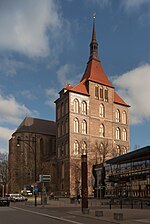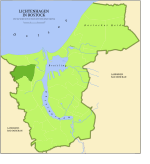St. Peter's Church, Rostock
14th-century churches in GermanyLutheran churches converted from Roman CatholicismLutheran churches in RostockRebuilt churches in GermanyTourist attractions in Rostock

St. Peter's Church, in German Petrikirche, was built in the 13th century and is the oldest of three town churches found in the Hanseatic city of Rostock, in northern Germany. The other two are St. Mary's Church (Marienkirche) and St. Nicholas (Nikolaikirche). A fourth, St. Jakobi, was heavily damaged during the Second World War and subsequently demolished.
Excerpt from the Wikipedia article St. Peter's Church, Rostock (License: CC BY-SA 3.0, Authors, Images).St. Peter's Church, Rostock
Bei der Petrikirche, Rostock Stadtmitte (Ortsbeirat 14 : Stadtmitte)
Geographical coordinates (GPS) Address Website External links Nearby Places Show on map
Geographical coordinates (GPS)
| Latitude | Longitude |
|---|---|
| N 54.090555555556 ° | E 12.148055555556 ° |
Address
Petrikirche
Bei der Petrikirche 1
18055 Rostock, Stadtmitte (Ortsbeirat 14 : Stadtmitte)
Mecklenburg-Vorpommern, Germany
Open on Google Maps











